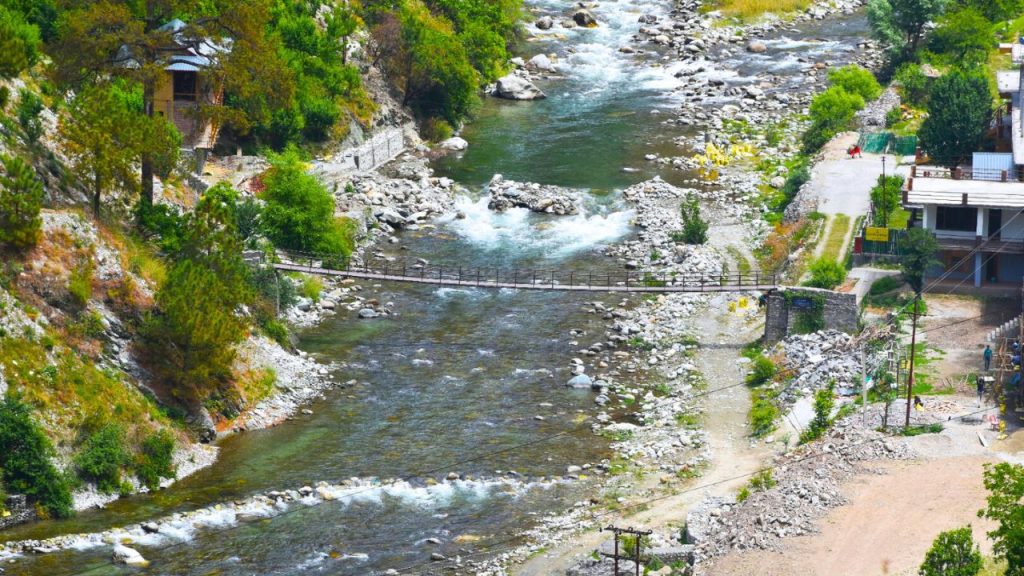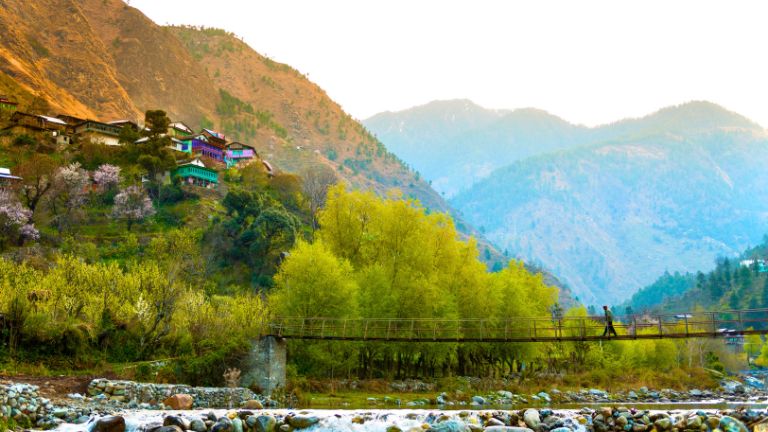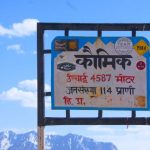The major entrance to the Great Himalayan National Park is in the Tirthan valley (GHNP). Actually, the secret valley would have likely stayed unknown without the national park. The Tirthan River, which originates in Tirth in the GHNP and empties into the Beas River in Larji, gives the valley its name. The valley is still in good shape and is a great place to go on vacation if you want to relax, especially when compared to other places in Himachal. There are many Himalayan villages in the area.
Banjar tehsil is located in the Kullu district of Himachal Pradesh and is known as Banjar Valley. Tirthan Valley is located in Banjar town, and the valley is known as Tirthan Valley because of the Tirthan River that runs through it.
The Trithan Valley, located in the Himachal Pradesh province’s Kullu district, is a fantastic vacation spot for all you adventure seekers out there. When you go to Tirthan Valley, which is about 3 km from the entrance to the Great Himalayan National Park, you’ll be able to see the ultimate beauty of nature, including Himalayan peaks that touch the sky, apple orchards, a vast sky, and much more.
Jibhi is another well-known or popular name from Banjar Valley, and there isn’t much difference between Banjar or Tirthan Valley, or Jibhi, except for the small village locations. All three are technically part of Banjar Valley and a few other nearby villages, where Gushaini and Jibhi are two of Tirthan’s most popular tourist destinations. Some people refer to Tirthan Valley as Trout Fishing Valley.
The Tirthan River, which flows beautifully through the valley, gave the area its name. As a result of all of this, Tirthan Valley Himachal Pradesh appears to be a paradise for nature enthusiasts. The region’s Great Himalayan National Park only enhances the allure of the region’s biodiversity of flora and fauna. There are also a few villages nearby that you could visit and talk to the people in to have a once-in-a-lifetime vacation.
When you visit Tirthan Valley, you can immediately sense nature’s raw, unadulterated bliss, with fresh air all around you and a cool breeze kissing your face. If you enjoy nature walks or trout fishing, don’t waste time planning your upcoming vacation in Himachal Pradesh; instead, fly from Delhi to Tirthan Valley.
What is its location?

Banjar or Tirthan is located on the Jalori Pass, connecting Kullu and Shimla. As a result, you can enjoy the thrilling drive over the Jalori Pass and complete the entire circuit in one trip, such as Manali to Tirthan Valley to Shimla or Mashobra.
Trekking in the Tirthan Valley
Tirthan Valley is a trekker’s paradise because it is the gateway to the Great Himalayan National Park. The valley offers a variety of treks ranging in length from two to fifteen days, with difficulty levels ranging from beginner to advanced. An experienced trekker can explore and reach altitudes of up to 4000 meters. Aside from long treks, Tirthan Valley offers day hikes in the woods or near a waterfall.
So, if you want to go hiking or trekking with your family or friends in a peaceful natural setting, take the road to Tirthan.
Weather in Tirthan Valley
The weather in Tirthan is pleasant for the majority of the year, with summer temperatures rarely exceeding 24 degrees Celsius. Because of the flowing river, there is usually a cool breeze. You can always feel the music in the air due to the flowing Tirthan river adjacent to the valley, and the abundance of greenery around you adds to that pleasant feeling.
The minimum temperature may drop below the freezing point during the winter, resulting in snowfall. During the winter months, the weather becomes particularly dry. Snow is expected in January and February, and you can always go for it at Jalori Pass.
Best time to go to Tirthan Valley?

Even though Tirthan is a lovely, quiet, relaxed, and pleasant place almost all year, it is incredibly refreshing and beautiful during the spring season, which runs from March to May. The beauty, which is brimming with apple orchards, is poised to mesmerize any soul on the planet. As a result, the spring season is the best time to visit Tirthan Valley.
Please keep in mind that Tirthan gets quite cold in the winter and is vulnerable to wildlife interference, mainly due to Leopards and Bears. Due to snow at higher elevations, wildlife is forced to descend into the valley. Leopards and bears are more likely to attack in the snow because there is less food in the mountains.
What if I don’t make it to Tirthan in March or April?
According to many people’s past experiences, including mine, this valley does not disappoint from March to November. It is an excellent time to visit if you don’t get to see Tirthan during the spring season.
The trout fishing season runs from March to October, but you’ll need to purchase a daily license, which costs Rs. 100 per person per fishing rod and is non-transferable.
How to reach Tirthan Valley

You will need to travel a total of 494, 1,901, 543, and 2,654 kilometers from Delhi, Mumbai, Kolkata, and Bengaluru, respectively, to get to Tirthan Valley Himachal Pradesh. See the information on how to get to Trithan. Trithan Valley to delhi is 494km away.
- By Air
Depart from Bhuntar Airport, also known as Kullu Manali Airport (KUU), which is 48-50 kilometers away. It is suggested that you take a connecting flight from Chandigarh or Delhi to get here. Consider hiring a cab or taking another form of public transportation to get to the valley from the airport.
From Delhi to tirthan, catch an Air India aircraft. The tickets begin at INR 4,000–5,000.
Leaving Chandigarh Airport, take an Air India flight. The tickets begin at INR 7,000–8,000.
- By Train
Ambala and Kirtapur railheads, which are respectively 250–300 and 200 kilometers apart, are the closest railway stations (IRCTC). Both stations have good transportation options within the adjacent towns and cities. However, as Kiratpur is the closest, you can think about disembarking there. To go to the valley from the station, you’ll need to take a cab or some type of public transportation.
- By Road
You can get to and from this location using either state-run or private buses, which are regularly available. You can also think about calling a cab or driving your own car here because the roads leading to Himachal are well-designed and maintained.
250 kilometers from Chandigarh via NH154, 293 kilometers via NH205 from Ludhiana, and 474 kilometers via Sirsa.
If you still have any queries related to your Himachal Trip. You can contact us by just clicking Here.
How do I get from Delhi to Tirthan Valley?
Because Tirthan Valley is in Himachal Pradesh’s Kullu region, you’ll need to take the Delhi-Manali Highway to a place called Aut after Mandi. You do not need to enter the Jawahar tunnel at Aut; instead, continue straight into Banjar Valley on the right-hand road. The Tirthan valley from Delhi is 496 km away.
The distance between Delhi and Tirthan Valley is approximately 511 kilometers via the Mandi-Pandoh route. The following is the complete route:
Delhi – Ambala (188 KM) – Chandigarh – Roopnagar (282 KM) – Kiratpur – Bilaspur (371 KM) – Mandi (440 KM) – Pandoh – Aut (481 KM) – Larji – Gushaini – Tirthan (511 KM)
Manali to Tirthan Valley
If you want to visit Tirthan from Manali, you’ll need to return to Delhi via Kullu. Take the left exit after reaching Aut and crossing the Jawahar Tunnel. (Warning: From here on out, the route is highly scenic ;)).
You will arrive at the Larji T-Point, where you must turn right to reach Sai Ropa. If you continue straight from Sai-Ropa, you will reach Banjar – Shoja – Jalori Pass; however, for Tirthan, take the U-Turn from there towards Gushaini-Nagni (Tirthan).
From Aut junction, it will take about 1.25-1.5 hours to drive to Tirthan villages.
There are six things to do in Tirthan Valley

So far, we’ve discussed the advantages of traveling to Tirthan from Manali or Delhi. But, once you arrive in Tirthan, what should you do? What are the tourist attractions in Tirthan Valley, or what are the tourist attractions in Tirthan Valley?
Let’s look at some of the places to visit in tirthan valley sights and activities.
1. The Great Himalayan National Park
You can go for treks, hikes, or evening camping in the wild because Tirthan is the gateway to GHNP. You can get a sense of nature by walking or hiking in it until you reach the inner entrance, after which daily permissions are required if you want to hike deeper into it. Hiking with family or friends is a lot of fun here.\
2. Waterfalls in Tirthan Valley
There are two secluded waterfalls within an hour’s hike, the higher of which is over 50 feet tall. Both of them are near one another. The aerial views of Tirthan from the waterfall trek are spectacular.
3. The journey to the Jalori Pass
Jalori Pass, at 3120 meters above sea level, is one of Himachal’s steepest passes, separating Kullu Valley from Shimla Valley. To reach the top, you must travel nearly 2500 meters in less than 25 kilometers. The gradient is exceptionally steep, and climbing up and down requires extreme caution. If you don’t use low gear braking, you may experience brake failure.
On the way back to Tirthan, stop at Shringi Vatika for a meal. From the end of December to the end of March, the Jalori Pass are cover in snow. In the winter, the road ahead of Shoja and the road to Shoja are close.
4. Jalori Pass Trek or Serloskar Lake Trek
The Serloskar Lake trek begins at Jalori Pass and ends about 5 kilometers later at Serloskar Lake. It will take two hours to get to the lake and another two hours to get back to Jalori. As a result, plan your hike to the lake and your day accordingly, or you may end up driving at night. The lake can be disappointing at times. Don’t forget to bring a bottle of water with you. This trek is sometimes referred to as the Jalori Pass trek.
5. Bachelo Pass should visit.
You can also visit this single pass from Tirthan Valley, about 15 km en route to Bathaad village. From December to February, the Bachelo Pass will cover in snow. As a result, you won’t be able to visit it during the winter.
6. Shangarh Valley – Sainj Valley
Sainj Valley, located 45 kilometers from Kullu in Himachal Pradesh, is a beautiful wonderland! You’re not the only one who has never heard of the place. At the height of 1233 meters, the valley begins close to the river.
7. Trout fishing:
Trout can be found in large numbers in the Tirthan River. This river, which is teeming with brown and rainbow trout, has become a favourite spot for anybody who enjoys spending time fishing.
When traveling to Tirthan Valley from the Larji Petrol Pump, turn left to travel to Sainj Valley, including places like Shangarh, Pundrik Rishi Lake, Dehuri, Manyashi, Shenshar, and Panihar. These are some of the villages where you can stay in a lovely homestay away from the crowds. Sainj Valley grew in popularity as an offbeat Himachal destination as Tirthan Valley became increasingly crowded.
Tirthan Valley Hotels
The Tirthan Valley offers a range of lodging options. Our recommendation is
- Tirthan Valley Stay.
- The Whispering Woods Tirthan
- The Tirthan Valley Wooden House
Conclusion
Tirthan Valley is still an off-the-beaten-path destination in Himachal Pradesh. It caters to all age groups, and a trip in the lap of mother nature at any time is always a warm experience.
F&Q’s Tirthan Valley
Why is Tirthan Valley famous?
Hiking along the wonderful mountain trails and admiring nature’s exotic beauty rejuvenates adventurers and trekkers. The green meadows, exclusive wild flora, and natural springs characterise the beauty of Tirthan valley, which is nestled in the solitude of the Himalayas.
Where is Tirthan located?
Tirthan Valley is located in Himachal Pradesh’s Kullu district and is named after the Tirthan river that runs through it. The pristine river flows from Hanskund, a snow-capped peak in the lush Great Himalayan National Park, and its icy cold glacial springs (GHNP)
Is Tirthan Valley worth visiting?
Tirthan valley’s rustic charm, pretty rivulets, insanely scenic hikes, and treks, the great Himalayan national park, and unique culture make it a must-see destination.
How can I go to Tirthan Valley from Delhi?
The nearest airport to Tirthan Valley is Bhuntar, approximately 48 kilometers away. Indian Airlines and Deccan Airways both fly to this region frequently. To get to the location, you can take a Jagson Airlines helicopter service, after which you can take a taxi.
Does it snow in Tirthan Valley?
Throughout the year, the temperature is very cold. This location receives up to 5-8 feet of snow in the winter. March remains the best month to visit Tirthan Valley due to the pleasant weather.
Which river is in Tirthan Valley?
The Tirthan River, which originates in the GHNP and flows from Tirth to Larji in the Beas River, gives the tirthan valley its name. Compared to other Himachal destinations, the valley has been well preserved and provides the ideal setting for those seeking a relaxing vacation.








